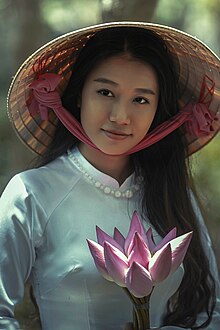TheAsian conical hatis a simple style ofconicallyshapedsun hatnotable in modern-day nations and regions ofChina,Vietnam,Korea,Japan,Philippines,Indonesia,Malaysia,Thailand,Cambodia,Laos,Myanmar,Bangladesh,India,Nepal,andBhutan.It is kept on the head by a cloth or fiber chin strap, an innerheadband,or both.



Regional names
editEnglish terms for the hat includesedge hat,rice hat,paddy hat,bamboo hat,and—historically but nowonly offensively[1][2]—cooliehat.[3]
InSoutheast Asia,it is known asdo'un(ដួន) inCambodia;capingorseraunginIndonesia;koup(ກຸບ) inLaos;terendakinMalaysia;ngop(งอบ) inThailand;khamauk(ခမောက်) inMyanmar;salakót (ᜐᜎᜃᜓᜆ᜔), sarók, sadók, s'laong, hallidung, kallugong,andtabungawamong other names in thePhilippines;andnón tơi or nón chằm láinVietnam.[citation needed]
InEast Asiait is calleddǒulì(Đấu lạp,literally meaning a "one-dǒubamboo hat ") in China;kasa(Lạp)in Japan; andsatgat(삿갓) inKorea.
InSouth Asia,it is known asjaapi(জাপি) inAssam(India); in Bangladesh it is known asmathal(মাথাল).[4]
Use
editAsian conical hats are, throughout Asia, primarily used as a form of protection from the sun and rain. When made of straw or other woven materials, it can be dipped in water and worn as an impromptu evaporative cooling device.[5]
China
editInChina,it was typically associated with farmers, whilemandarinswore tighter circular caps, especially in the winter.[6]There are several conical hat types worn during the Qing dynasty (seeQing official headwear).
Japan
editIt is also widely understood in East Asia, most notably Japan, where they were known askasa,as a symbol ofBuddhism,as it is traditionally worn bypilgrimsand Buddhist monks in search ofalms.
Sturdier, even metal, variants, known asjingasa(battle kasa), were also worn bysamuraiand foot-soldiers in Japan, as helmets.[citation needed]
Philippines
editIn thePhilippines,thesalakótis more commonly a pointed dome-shape, rather than conical, with a spike or knobfinial.Unlike most other mainland Asian conical hats, it is characterized by an inner headband in addition to a chinstrap. It can be made from various materials includingbamboo,rattan,nito,bottle gourd,buristraw,nipaleaves,pandanleaves, andcarabaohorn. The plain type is typically worn by farmers, but nobles in the pre-colonial period (and laterprincipaliain the Spanish period) crafted ornate variations with jewels, precious metals, ortortoiseshell.These are considered heirloom objects passed down from generation to generation within families.[7][8]
Thesalakótwas also commonly worn by native soldiers in theSpanish colonial army.It was adopted by Spanish troops in the early 18th century as part of their campaign uniform. In doing so, it became the direct precursor of thepith helmet(still calledsalacotorsalaccoin Spanish and French).[9]
Vietnam
editInVietnam,the nón lá,nón tơi( “hats” ),nón gạo( “rice hat” ),nón dang( “conical hat” ) ornón trúc( "bamboo hat" ) forms a perfect right circularconewhich tapers smoothly from the base to the apex. Special conical hats in Vietnam contain colourful hand-stitch depictions or words. TheHuếvarieties are famous for theirnón bài thơ(lit. poem conical hats) and contain random poetic verses andChữ Hán,which can be revealed when the hat is directed above one's head in the sunlight. In modernity, they have become part of Vietnam's national costume.[10]
Others
editIn India, Bangladesh[11]and Borneo, the plain conical hat was worn by commoners during their daily work, but more decoratively-colored ones were used for festivities. InSabah,the colorful conical hat is worn for certain dances while in Assam they are hung in homes as decoration or worn by the upper classes for special occasions.[citation needed]
Gallery
edit-
A selection of conical hats inHainan,China
-
Souvenirnón tơifor tourists from Vietnam
-
A silver inlaid Filipinosalakót
-
A Korean man in traditional mourning clothes andsatgat
-
Making conical hats (nón tơi) inHuếcountryside, Vietnam
-
ThreeSama-Bajauwomen wearingsarukfrom Jolo, Sulu, Philippines, c.1900
See also
edit- Fulani hat
- Gat
- List of hats and headgear
- Mokoliʻi,an island in Hawaii with a nickname "Chinaman's Hat"
- Ngob
- Pilgrim's hat
- Pointed hat
References
edit- ^"Definition of COOLIE".www.merriam-webster.com.RetrievedJanuary 5,2022.
- ^"Definition of coolie | Dictionary.com".www.dictionary.com.RetrievedJanuary 5,2022.
- ^"Coolie hat - Definition and More from the Free Merriam-Webster Dictionary".
- ^"Bamboo Craft".Banglapedia.
- ^"Conical Hats".Nguyentientam.com.RetrievedMay 23,2012.
- ^Chisholm, Hugh,ed. (1911)..Encyclopædia Britannica.Vol. 17 (11th ed.). Cambridge University Press. pp. 55–559, see page 558, lines 3 to 5.
The term 'mandarin' is...[applied]... only to those who are entitled to wear a 'button,' which is a spherical knob, about an inch in diameter, affixed to the top of the official cap or hat
- ^Peralta, Jesus T. (2013).Salakot and Other Headgear(PDF).National Commission for Culture and the Arts (NCCA) & Intangible Cultural Heritage in the Asia-Pacific Region (ICHCAP),UNESCO.p. 232.
- ^Nocheseda, Elmer I."The Filipino And The Salacot".Tagalog Dictionary.RetrievedMarch 3,2020.
- ^Antón, Jacinto (December 5, 2013)."La romántica elegancia de Salacot".El País.Archivedfrom the original on April 3, 2017.RetrievedMay 3,2018– via elpais.com.
- ^"Vietnamese Costumes: Non toi".
- ^মৃত্যুঞ্জয় রায় (April 17, 2022)."বাংলার মাথাল"[Mathalof Bengal].Daily Naya Diganta(in Bengali). Dhaka, Bangladesh.RetrievedNovember 14,2023.